At The Coombes School,Susan Rowe and Susan Humphries have helped to cultivate a thriving ecosystem with authentic learning experiences...
When our school opened in 1971 we wanted to create a setting that would offer the best possible learning environment for the children. Our plan was that indoors and outdoors should both complement and inform each other.
The transformation of the school grounds brought with it a proliferation of flora and fauna. The children had guaranteed contact with insects, minibeasts, amphibians, birds and small mammals. We also wanted to give them opportunities to care more directly for other living things and in 1980 our first orphan lambs, Bill and Bluebell, arrived at two days old from a local farm. The children helped to rear them for six months before the lambs went to join a local shepherd’s flock. Bill and Bluebell were followed by Rosie and Tim who formed the nucleus of our own small flock. Each winter a ram would join the ewes so that we would have lambs in the Spring. In this way the children learned more about the cyclical nature of life, the process of reproduction and the responsibilities entailed in caring for animals.
The sheep provided the focus for teaching and learning in all curriculum areas in an authentic and relevant way, ensuring integrated curriculum coverage based on first-hand, experiential learning in the outdoors.
The school owns four sheep. They are part of the outdoor setting and are moved around the grounds in mobile fencing or pastured in one of two small fenced paddocks. Both small paddocks have been planted with fruit trees by the children. Grass in these areas and in the margins of the playing field is rotationally cropped by the sheep, which aerates and manures the ground, favouring the spread of violets, primroses and cowslips the teachers and children have added year by year.
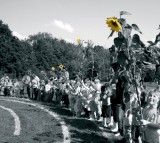 At some point during the spring and autumn the sheep are grazing either under trees in blossom or fruit. This combines to make the area strikingly attractive. The sheep are always a strong presence in the grounds. They act as a hub of interest involving the life of another species. Sheep watching and touching can have a restorative and spiritual quality for many children and adults.
At some point during the spring and autumn the sheep are grazing either under trees in blossom or fruit. This combines to make the area strikingly attractive. The sheep are always a strong presence in the grounds. They act as a hub of interest involving the life of another species. Sheep watching and touching can have a restorative and spiritual quality for many children and adults.
A peripatetic shepherd checks the health of the animals from time to time and he brings a ram to stay with the flock for six weeks. This is arranged so that mating might be seen incidentally but it is talked of in a very relaxed way: the children understand that if the sheep are to have lambs, the mating must happen first.
After two or three days following birth and providing they have bonded well with their mothers, the lambs are taken into the classroom for short periods to be weighed, cuddled and enjoyed at close range.
Not all pregnancies result in a successful birth and death is a fact of life and sensitively explained in these terms. The children are reminded about the unbroken series of births and deaths among the sheep that speak of the continuity of life and, for us, dates back 28 years to the time the school adopted two orphan lambs. We view parts of this story in photographs that remind us all of the recurring patterns.
Our shepherd brings in a ram of his own to shear before our Textiles Day and he also shears three of our small flock. On this occasion, he uses old-fashioned hand shears rather than electric ones. This organisation makes it possible for two classes at a time to see detail in the shearing and watch from closer quarters. Shearing is a very physical exercise for the shepherd and he must talk about his tools, the order in which he moves his shears along the line of the animal’s body and so on before he starts. He needs to prime the children for the sight of blood spots because it is easy to nick the skin of the sheep. He also explains to the children that the sheep will probably evacuate because this is also common.
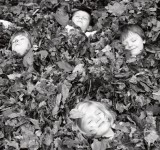 Morris the shepherd points out that the fleece should be kept as clean as possible and that once he has started to shear the sheep he will not stop until the job is finished. The school animals are not easily phased by crowds of children but there are degrees of tension about being sheared.
Morris the shepherd points out that the fleece should be kept as clean as possible and that once he has started to shear the sheep he will not stop until the job is finished. The school animals are not easily phased by crowds of children but there are degrees of tension about being sheared.
Morris shows the purple antibiotic spray used for the treatment of any cuts. He tells the children that they can measure his success as a shearer if he can remove the fleece by following its contours and not breaking it. The fleece will be laid out on the pavers so that a plan of the animal’s body is the result. Before the sheep come into the area, we ask the children to keep as still and quiet as possible.
The shearer’s hands move along the sheep’s body in a fluid movement and the fleece ripples off showing the creamy underside of the wool growing closest to the body. Before shaking the fleece out to demonstrate his skill, Morris ttends to any blood spots. The sheep is confused by its sudden loss of weight and we can clearly see its bony framework. We are always taken aback by how slight the sheep are under their coats. The children are thoughtful during this time and there are many empathetic moments; the children frequently comment that they feel sorry for the sheep.
Morris explains that the sheep need relief from the flies that breed in their long wool and he talks about the benefits of being freed of their long coats during summer. The sheep is then led away and we do any necessary tidying up. After this Morris shakes out the fleece for examination: as one child summed up, ‘That’s a flat pack of the sheep.’ Some children draw around the outline of the fleece with charcoal before Morris gathers it up. We throw the fleece to one another to verify its functional shape and it is passed around so that all the children can assess the feel and weight of the bundle.
In the classroom the fleece is weighed and divided between the two classes who watched it sheared for washing, carding, dyeing and other experiments. In this way the children refer to the demonstration with specific regard to history, maths and science and they use the new words they have learned. This sequence is followed two classes at a time, including the youngest nursery children. The nursery children often wash their wool on that same day: they mix soap flakes into warm water and they squeeze and rub the wool in one of the water trays. Another water tray is used for rinsing and then the clumps of wool are pegged on a line to dry.
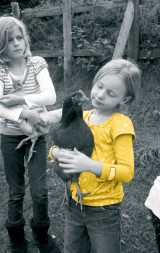 Older children also wash the fleeces by hand to free the wool of some of its lanolin and dirt and they put them on bushes to dry inthe time-honoured way. We own several sets of carders and the children use these to disentangle the woollen fibres in preparation for the textile-making workshop.
Older children also wash the fleeces by hand to free the wool of some of its lanolin and dirt and they put them on bushes to dry inthe time-honoured way. We own several sets of carders and the children use these to disentangle the woollen fibres in preparation for the textile-making workshop.
Membership of the carders group is ad hoc and supported by parents and visitors joining in for the odd 10 minute session. It is a job made pleasant by group talk and work and often includes humming or singing. Pulling a set of two wire combs against each other creates a lot of friction and it could be a dreary chore to tease out the fibres unless you feel motivated by the social context.
The adults may talk to the children about metaphors and their relationship with working with fleece: ‘Stop picking on me!’, ‘I’m teasing out the problem’, ‘You’re teasing me’, ‘This is a knotty problem’. These are sayings that have their roots in the past and they relate to the preparation of fleeces – a time-consuming job in the early days
Two of our teachers, Carol and Judy, do many experiments with the children to dye fleece using plants from the school gardens. We grow woad for this purpose and we also extract dyes from mint, stinging nettles, beetroot, green walnuts, spinach and onionskins (available in our gardens).
The dyes are fixed in the fleece using vinegar or alum. All the colours obtained are muted but later, when the wool is woven orknitted the stripes of different tones combine well.
We collect the fables, parables, poetry and stories that are connected to wool and sheep and incorporate them in our work. Fortunes have been made from the backs of sheep and the Jack of Newbury tale is an historic incident that demonstrates this. In the story, a wealthy aristocrat laid a wager claiming that it was not possible to be clothed in a suit that had doubled as sheep’s clothing on the same day. Jack of Newbury rose to the challenge and with the townspeople acting as witnesses he had the sheep sheared at dawn.
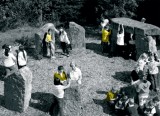 A determined workforce organised by Jack fitted the aristocrat with his new clothes before sunset on the same day. We outline the story emphasising the processes and friends from local crafts guilds, parents and children help to manufacture something that can be worn by the end of the school day. Over the years we have produced knitted and woven scarves and small pram blankets. When we follow this scenario, the experiences themselves are the rationale for doing the work but they also raise the need for the specialised language. The why and wherefore of the depictive phrases, ‘looking sheepish’, ‘making sheep’s eyes’, ‘trimmed down to size’ become clearer following the shearing of sheep because the animals are noticeably thinner when they are ‘fleeced’ and quite giddy with weightlessness.
A determined workforce organised by Jack fitted the aristocrat with his new clothes before sunset on the same day. We outline the story emphasising the processes and friends from local crafts guilds, parents and children help to manufacture something that can be worn by the end of the school day. Over the years we have produced knitted and woven scarves and small pram blankets. When we follow this scenario, the experiences themselves are the rationale for doing the work but they also raise the need for the specialised language. The why and wherefore of the depictive phrases, ‘looking sheepish’, ‘making sheep’s eyes’, ‘trimmed down to size’ become clearer following the shearing of sheep because the animals are noticeably thinner when they are ‘fleeced’ and quite giddy with weightlessness.
The weaver uses the shuttle to pass a weft thread backwards and forwards between the warp threads and while he or she does this, a spare shuttle is passed round the group. The teacher mentions the shuttle bus that travels between the park and ride centre and the town of Reading. The to and fro shuttle has given its name to vehicles going backwards and forwards over distance. We also think about the phrase ‘on tenterhooks’: newly produced wool was attached to hooks stretched across large frames – these were known as tenters.
The experience of crosscurricular and integrated curriculum work on a topic like sheep is an example of work that matters to us all. The children are learning in the context of a teaching and learning community and all the adults exchange ideas with them and with one another because they are still en route to becoming better in their field. The basis for learning is the sharing of problems and skills, a curiosity about everything and plenty of opportunities for consolidating social skills and working cooperatively. Many subject areas are covered and the children are partaking at every stage. In this set up, artistic parents and visiting crafts people are coleading each other and us. It is a demonstration about the pleasure of sharing – progress is interdependent and there is much to learn in this.
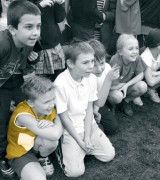 The whole school decides on names for our new born lambs. We hold an election day on which everyone votes for their favourite names. After discussion, each class submits a name for each lamb and these are circulated to the other classes. We set up the school hall with a table with an adult helper to act as an Electoral Officer distributing voting papers for each lamb name.
The whole school decides on names for our new born lambs. We hold an election day on which everyone votes for their favourite names. After discussion, each class submits a name for each lamb and these are circulated to the other classes. We set up the school hall with a table with an adult helper to act as an Electoral Officer distributing voting papers for each lamb name.
Classes in turn come to the hall and the children cast a vote for their favourite name for each lamb. The adults give help to those children who cannot yet read fluently. Polling closes when every person in the school has had a chance to vote. An adult returning officer helped by child stewards counts the votes for each lamb’s name and announces the results to the whole school. We try to make the experience as similar as we can to that which the children will see on the television whenever there is a local or national election.
The growing, harvesting, preparation and eating of food is a particular characteristic of our school. We reinforce the children’s understanding of a healthy, balanced diet and of the need to care for our teeth but at the same time we are great believers in the notion of ‘eating our learning’. We know that particular tastes will be remembered for much longer than the event of which they are part. Most subject areas and particular themes will have a food element running through that will add extra interest or novelty. A phonics session focusing on the ‘ch’ phoneme will be more memorable if the children get tastes of chestnuts, chipolatas or cherries. Chinese New Year will be remembered as much for the flavours of the orient as other details; year on year, the children can recall their use of unfamiliar chopsticks or the taste of a freshly made stir fry. The Jewish festival of Hannukah will be remembered for the doughnuts so generously donated by our Jewish parents as well as for the origins of this festival of light. The celebration of Diwali will stand out because of the curry and chapattis we have tasted as well as for the paths of light that we all walked.
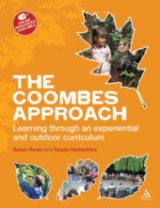
Over the last 40 years, the Coombes School in Berkshire has developed an international reputation for its innovative approach to Nursery and Infant teaching. The Coombes Approach (Continuum, 2012) covers a comprehensive range of topics from curriculum design, pastoral care and the wider policy and community contexts in which the school has operated. In particular, the book focuses on the innovative use of the school’s environment as a unique outdoor classroom. Supported by an online resource bank of pictures of the school environment and pupils’ activities, this is an essential read for school leaders seeking to learn from the successes of the Coombes School’s unique approach to teaching
Susan Humphries became the founding headteacher of The Coombes School in 1971. Susan Rowe joined the school in 1978, became head in 2003 and retired in 2010.
Make World Book Day Extra Special This Year
Ace-English
Behaviour management: choosing the right words
Behaviour Management
